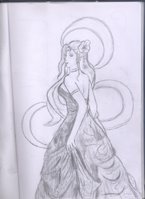The Raven
Over many a quaint and curious volume of forgotten lore—
While I nodded, nearly napping, suddenly there came a tapping,
As of some one gently rapping, rapping at my chamber door.
“‘Tis some visitor,” I muttered, “tapping at my chamber door—
Only this, and nothing more.'
Ah, distinctly I remember it was in the bleak December,
And each separate dying ember wrought its ghost upon the floor.
Eagerly I wished the morrow;—vainly I had sought to borrow
From my books surcease of sorrow—sorrow for the lost Lenore—
For the rare and radiant maiden whom the angels name Lenore—
Nameless here for evermore.
And the silken sad uncertain rustling of each purple curtain
Thrilled me—filled me with fantastic terrors never felt before;
So that now, to still the beating of my heart, I stood repeating,
“‘Tis some visitor entreating entrance at my chamber door—
Some late visitor entreating entrance at my chamber door;—
This it is, and nothing more.'
...
Above is an excerpt from 'The raven' which is one of my favourite poems written by the American writer and poet Edgar Allan Poe. Many say he is a master of horror genre in Literature. Like the other works by this talented writer, the poem is dark, mystic, covering with supernatural atmosphere and inner thoughts. Its underlying musicality is built on the mastery stylized languague. The poem tells of the strage midnight visit of a talking raven to a desperate lover, pulling him down into madness. The raven seems to come from Hell, "from the night's plutonian shore" (Pluto, in Roman Mythology is the Underworld God), and carries with it the unceasingly haunting message "Nevermore". According to Poe, the concept of self-destroying anguish over the death of a lover is the most poetic topic and he is successful in framing it throughout the poem. I'm impressed by his idea that "Guilt" is the inner desire of destroying oneself, not the thing to be judged by moral standard that the person's living in.










